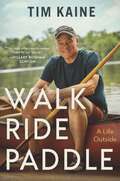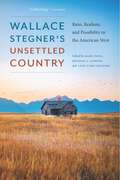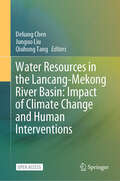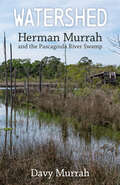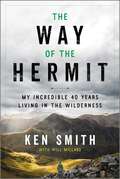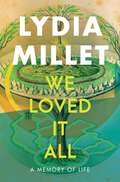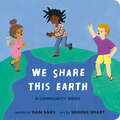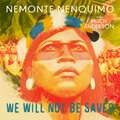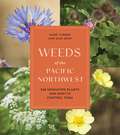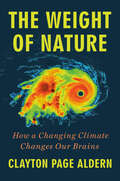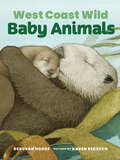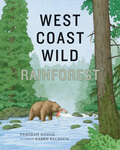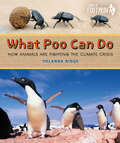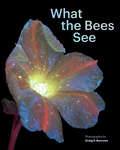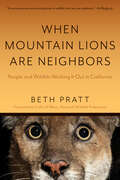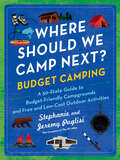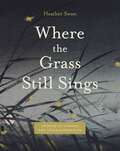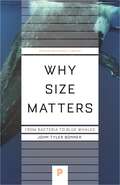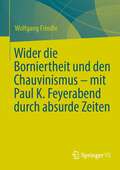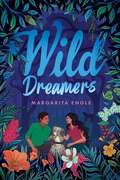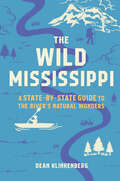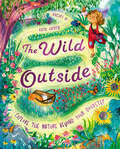- Table View
- List View
Walk Ride Paddle: A Life Outside
by Thomas NelsonA compelling account of one man&’s journey across hundreds of miles of Virginia wilderness and a moving testament to the optimistic spirit of America, Walk Ride Paddle provides an unseen glimpse into a life outside. In 2019, Tim Kaine—Virginia senator and former Democratic vice presidential candidate—commemorated both his sixtieth birthday and his twenty-fifth year in public office by undertaking a three-part journey across the Virginia landscape as he hiked, cycled, and canoed across the state. His chronicle became an organic reflection of the extraordinary events occurring across America during that time, including two impeachment trials, a global pandemic, growing racial protests, the January 6 attack on the Capitol, and more.During weekends and in Senate recess weeks, Kaine—over a period of several years—hiked the 559 miles of the Appalachian Trail that cross Virginia from Harpers Ferry to the Tennessee border; biked 321 miles along the crest of the Virginia Blue Ridge on the beautiful parkways built during the Great Depression to create jobs and give everyday people on the East Coast an accessible place to vacation; and canoed the entire James River—348 miles from its headwaters in the Allegheny Mountains to its entrance into the Chesapeake Bay. Along the way, Kaine reflected on the events that have shaped both his life and the world around him, sharing his deep love for the natural world and the importance of preserving it for future generations in a fascinating memoir that blends adventure, reflection, and political insight.With immediacy and honesty, Kaine pulls back the curtain to reveal his inner thoughts during such monumental times. Kaine&’s storytelling gift and wise observations offer a fascinating glimpse into the mind of a seasoned politician and outdoor enthusiast.Walk Ride Paddle is a captivating memoir of one man&’s physical journey through the Virginia wilderness—but it is also a unique and ultimately optimistic perspective on these pivotal moments in history, offering inspiration, wisdom, and hope.
Wallace Stegner's Unsettled Country: Ruin, Realism, and Possibility in the American West
by Mark Fiege Michael J. Lansing Leisl Carr ChildersWallace Stegner is an iconic western writer. His works of fiction, including the Pulitzer Prize–winning Angle of Repose and Big Rock Candy Mountain, as well as his nonfiction books and essays introduced the beauty and character of the American West to thousands of readers. Wallace Stegner&’s Unsettled Country assesses his life, work, and legacy in light of contemporary issues and crises. Along with Stegner&’s achievements, the contributors show how his failures offer equally crucial ways to assess the past, present, and future of the region. Drawing from history, literature, philosophy, law, geography, and park management, the contributors consider Stegner&’s racial liberalism and regional vision, his gendered view of the world, his understandings of conservation and the environment, his personal experience of economic collapse and poverty, his yearning for community, and his abiding attachment to the West. Wallace Stegner&’s Unsettled Country is an even-handed reclamation of Stegner&’s enduring relevance to anyone concerned about the American West&’s uncertain future.
Water Resources in the Lancang-Mekong River Basin: Impact of Climate Change and Human Interventions
by Qiuhong Tang Deliang Chen Junguo LiuThis open access book provides a comprehensive, up-to-date picture of the current state of knowledge covering climate change, surface water change, arsenic pollution, water utilization, water-food-energy nexus, water related hazards, water management, and water governance in the Lancang-Mekong River Basin. Considering the widely concerned fact that the climate change and human intervention induced impacts on water will bring unprecedented threats to human societies and ecosystems, the book intends to support UN’s sustainable development goals through sustainable use of water by providing the most accurate and updated information on climate and water changes in a consistent way. Underlying all aspects of the book is a strong commitment to assessing the science comprehensively, without bias and in a way that is relevant to policy but not policy prescriptive. It can provide implications to support decision-makers and stakeholders for integrated water resources management and sustainable development at all levels.
Watershed: Herman Murrah and the Pascagoula River Swamp
by Davy MurrahThe Pascagoula River is the largest unobstructed river in the contiguous United States. Because of this lack of restraint, the river has been left to rise and fall naturally with the seasons, overflowing annually into the adjoining bottomland forest. This phenomenon makes the Pascagoula River one of the wildest rivers, surrounded by some of the most ecologically diverse woodlands, in North America.Herman Murrah (1935–2002) lived his entire life on the banks and in the swamp surrounding this river in southeast Mississippi. Watershed: Herman Murrah and the Pascagoula River Swamp recounts pivotal moments in Herman’s life and in Mississippi’s conservation history more broadly. In this book, Herman’s eldest son, Davy, details the adventures that continue to inspire young conservationists in the fight to protect our remaining natural ecosystems.As a young adult, Herman worked as a game warden in the Pascagoula River Swamp. When the Pascagoula Hardwood Company, then owners of the swamp, decided to sell the vast tract of forest for clearcutting, Herman was incensed. Determined to protect this natural wonder, Herman teamed up with other visionaries to persuade the State of Mississippi to purchase the land and preserve it in perpetuity to the benefit of future generations of humans and wildlife alike. Eventually, the state agreed and finalized the purchase. Herman was appointed area manager for the upper portion of the newly designated Pascagoula River Wildlife Management Area. He dedicated the remainder of his life to preserving, protecting, and improving the swamp for the good of south Mississippi.
Watery Planet: How a water crisis is impacting our world
by Anna ClaybourneWatery Planet offers young readers a clear, insightful look at Earth's ongoing water challenges.Water makes our life on Earth possible. We need water not just to drink and keep clean, but also for agriculture, industry, transport and much, much more. But despite having an enormous amount of water on Earth, only 1 per cent of it is available for us to use and it's at increasing risk.Watery Planet looks at the reasons behind our looming water crisis - from uneven distribution to water wastage, pollution and climate change. It explores how floods, droughts and rising sea levels are becoming a stark reality as the world warms and describes how we are adapting to these challenges. It also looks at some positive, practical solutions to our water problems and explains how we can all do our part to help save Earth's most precious resource.Contents:A WHOLE WORLD OF WATER WE ALL NEED WATER! HOW WE GET WATER IS THERE ENOUGH WATER? WATER AND HEALTH CASE STUDY: COLLECTING WATER IN ETHIOPIA WATER POLLUTION WATER AND GLOBAL WARMING FLOODS AND DROUGHTS CASE STUDY: PAKISTAN FLOODS RISING SEA LEVELS WATER AND NATURE WATER AND WILDLIFE CASE STUDY: THIRSTY AVOCADOS DOING THINGS DIFFERENTLY WATER FOR THE WORLD CASE STUDY: THE ARAL SEA WATERY HOMES WHAT CAN YOU DO? THE FUTURE OF WATER GLOSSARY FURTHER READING INDEX Titles in this series:Plastic PlanetHot PlanetRecycled PlanetSustainable PlanetExtinction PlanetPeaceful Planet?Unequal Planet
The Way of the Hermit: My Incredible 40 Years Living in the Wilderness
by Ken SmithSubconsciously, I pressed myself into the loch's banks as that summer inched forward. We'd got off to a rocky beginning, but I started to see Treig in a different way. There was something about this land that told me just to hold on a while longer. It might've been just a whisper at the time, but I knew it was definitely worth heeding. I just knew that was it. This was the place.Seventy-four-year-old Ken Smith has spent the past four decades in the Scottish Highlands. His home is a log cabin nestled near Loch Treig, known as "the lonely loch," where he lives off the land. He fishes for his supper, chops his own wood and even brews his own tipple. He is, in the truest sense of the word, a hermit.From his working-class origins in Derbyshire, Ken always sensed that there was more ot life than an empty nine to five. Then one day in 1974, an attack from a group of drunken men left him for dead. Determined to change his prospects, Ken quit his job and spent his formative years traveling in the Yukon. It was here, in the vast wilderness of northwestern Canada, that he honed his survival skills and grew closer to nature. Returning to Britain, he continued his nomadic lifestyle, wandering north and living in huts until he finally reached Loch Treig. Ken decided to lay his roots amongst the dense woodland and Highland air, and has lived there ever since.In The Way of the Hermit, Ken shares the remarkable story of his lfe for the very first time. Told with humor and compassion, his unique insights allow us to glimpse the awe and wonder of a life lived in nature and offer wisdom on how each of us can escape the pressures and stresses of modern life.
We Loved It All: A Memory of Life
by Lydia MilletNamed a Most Anticipated Book of 2024 by the Washington Post, Oprah Daily, and Literary Hub This lucent anti-memoir from celebrated novelist Lydia Millet explores the pain and joy of being a parent, child, and human at a moment when the richness of the planet’s life is deeply threatened. Across more than a dozen acclaimed works of fiction, readers have become intimate with Lydia Millet’s distinctive voice and sly wit. We Loved It All, her first nonfiction book, combines the precision of fact with the power of narrative to evoke our enmeshment with the more-than-human world. Emerging from Millet’s quarter century of wildlife and climate advocacy, We Loved it All marries scenes from her life with moments of nearness to “the others”— the animals and plants with whom we share the earth. Accounts of fears and failures, jobs and friendships, childhood and motherhood are interspersed with exquisite accounts of nonhumans and arresting meditations on the power of story to shape the future. Seeking to understand why we immerse ourselves in the domestic and immediate, turning away from more sweeping views, she examines how grand cultural myths can deny our longing for the company of nature and deprive us of its charisma and inspiration. In a thrilling distillation of experience and emotion, she evinces the familiar sense of feeling both well-meaning and powerless—a creature subject to forces that are baffling in their immensity. The fear and grief of extinction and climate change, Millet suggests, are forms of love that might be turned to resistance. We Loved It All shimmers with curiosity and laconic humor yet addresses with reverence the most urgent crises of our day. An incantatory, bewitching devotional to the vast and precious bestiary of the earth, it asks that we extend to other living beings the protection they deserve—the simple grace of continued existence.
We Share This Earth: A Community Book (Community Books)
by Dan SaksA rhyming, heartfelt celebration of the worldwide community and the vital role it plays in young children&’s lives.This formative board book is an appreciation of our global community and the many ways in which it helps develop empathy, compassion, and collective responsibility. Specific examples of shared community are depicted across twelve countries, inviting young readers to connect with and acknowledge the importance of caring about and for one another, and the Earth we share.
We Will Not Be Saved: A memoir of hope and resistance in the Amazon rainforest
by Nemonte Nenquimo'Nemonte's writing is as provocative as it is inspiring' EMMA THOMPSON'One of the most effective leaders for indigenous rights and environmental justice' LAURENE POWELL JOBS'I'm here to tell you my story, which is also the story of my people and the story of this forest.'Born into the Waorani tribe of Ecuador's Amazon rainforest, Nemonte Nenquimo was taught about plant medicines, foraging, oral storytelling, and shamanism by her elders. Age 14, she left the forest for the first time to study with an evangelical missionary group in the city. Eventually, her ancestors began appearing in her dreams, pleading with her to return and embrace her own culture.She listened. Two decades later, Nemonte has emerged as one of the most forceful voices in climate-change activism. She has spearheaded the alliance of indigenous nations across the Upper Amazon and led her people to a landmark victory against Big Oil, protecting over a half million acres of primary rainforest. Her message is as sharp as the spears that her ancestors wielded - honed by her experiences battling loggers, miners, oil companies and missionaries.In this astonishing memoir, she partners with her husband Mitch Anderson, founder of Amazon Frontlines, digging into generations of oral history, uprooting centuries of conquest, hacking away at racist notions of Indigenous peoples, and ultimately revealing a life story as rich, harsh and vital as the Amazon rainforest herself.More praise for We Will Not Be Saved: 'A radical manifesto for our times' VANESSA KIRBY'An act of storytelling generosity' NATHALIE KELLY'Inspiring, moving and unforgettable' ROWAN HOOPER'Truly Inspiring and humbling' CAROLINE SANDERSON** Publishing in the US as WE WILL BE JAGUARS**
We Will Not Be Saved: A memoir of hope and resistance in the Amazon rainforest
by Nemonte Nenquimo** Publishing in the US as WE WILL BE JAGUARS**'I'm here to tell you my story, which is also the story of my people and the story of this forest.'Born into the Waorani tribe of Ecuador's Amazon rainforest, Nemonte Nenquimo was taught about plant medicines, foraging, oral storytelling, and shamanism by her elders. Age 14, she left the forest for the first time to study with an evangelical missionary group in the city. Eventually, her ancestors began appearing in her dreams, pleading with her to return and embrace her own culture.She listened. Two decades later, Nemonte has emerged as one of the most forceful voices in climate-change activism. She has spearheaded the alliance of indigenous nations across the Upper Amazon and led her people to a landmark victory against Big Oil, protecting over a half million acres of primary rainforest. Her message is as sharp as the spears that her ancestors wielded - honed by her experiences battling loggers, miners, oil companies and missionaries.In this astonishing memoir, she partners with her husband Mitch Anderson, founder of Amazon Frontlines, digging into generations of oral history, uprooting centuries of conquest, hacking away at racist notions of Indigenous peoples, and ultimately revealing a life story as rich, harsh and vital as the Amazon rainforest herself.The Waorani language (referred to as Wao Tededo in the audiobook) is one of the world's most endangered languages and is only spoken by around 2,000 people. The Publishers would like to thank Oswando Nenquimo (Opi) and Connie Dickinson as well as the Endangered Languages Archive https://www.elararchive.org/ and the Endangered Languages Documentation Program https://www.eldp.net/ for their valuable support in ensuring accurate pronunciation of Waorani names and terms.
Weeds of the Pacific Northwest: 368 Unwanted Plants and How to Control Them
by Sami Gray Mark TurnerA comprehensive guide to the most common weeds of the Pacific Northwest, with essential information on their management and eradication Weeds are everywhere. They crowd out valuable agricultural crops, compete with the tomatoes and beans in your vegetable garden, spread rampantly along roadsides, and pop up from the tiniest cracks in sidewalks. In order to manage them, we must first learn how to identify them. Weeds of the Pacific Northwest is a guide to identifying, controlling, and eradicating over 300 species of weeds that gardeners and homeowners are likely to encounter in Northern California, Oregon, Washington, and British Columbia. Though they can all cause trouble, each weed is different. The hundreds of user-friendly photographs and detailed descriptions of each species here ensure that you can spot and treat any weed in your path. As the experts behind this book demonstrate, some plants can be killed by eating them, some by digging, some by smothering, and some only by the judicious application of chemical herbicides—and it is very important for you and your neighbors to know and understand the differences.
The Weight of Nature: How a Changing Climate Changes Our Brains
by Clayton Page AldernA deeply reported, eye-opening book about climate change, our brains, and the weight of nature on us all. The march of climate change is stunning and vicious, with rising seas, extreme weather, and oppressive heat blanketing the globe. But its effects on our very brains constitute a public-health crisis that has gone largely unreported. Based on seven years of research, this book by the award-winning journalist and trained neuroscientist Clayton Page Aldern, synthesizes the emerging neuroscience, psychology, and behavioral economics of global warming and brain health. A masterpiece of literary journalism, this book shows readers how a changing environment is changing us today, from the inside out. Aldern calls it the weight of nature. Hotter temperatures make it harder to think clearly and problem-solve. They increase the chance of impulsive violence. Immigration judges are more likely to reject asylum applications on hotter days. Umpires, to miss calls. Air pollution, heatwaves, and hurricanes can warp and wear on memory, language, and sensory systems; wildfires seed PTSD. And climate-fueled ecosystem changes extend the reach of brain-disease carriers like mosquitos, brain-eating amoebas, and the bats that brought us the mental fog of long COVID. How we feel about climate change matters deeply; but this is a book about much more than climate anxiety. As Aldern richly details, it is about the profound, direct action of global warming on our brains and behavior—and the most startling portrait yet of unforeseen environmental influences on our minds. From farms in the San Joaquin Valley and public schools across the United States to communities in Norway&’s Arctic, the Micronesian islands, and the French Alps, this book is an unprecedented portrait of a global crisis we thought we understood.
West Coast Wild Baby Animals (West Coast Wild)
by Deborah HodgeMeet the wild baby animals of the Pacific west coast! Wolf pups, bear cubs, whale calves and eaglets are thriving in the ancient rainforest, rugged beach and majestic ocean of the Pacific west coast. This sweet introduction to baby animal names and behaviours, with gorgeous watercolor scenes, will delight toddlers and babies everywhere! Key Text Features illustrations
West Coast Wild Rainforest (West Coast Wild #5)
by Deborah HodgeStep into the majestic rainforest of the Pacific west coast and discover a unique community of creatures thriving in an interconnected web of life. Towering over the sea, along the magnificent Pacific west coast, is an ancient and beautiful rainforest with a unique ecosystem that is linked in many ways. In this fourth book in the West Coast Wild series, you will find trees as tall as twenty-storey buildings, tiny seedlings sprouting on nursery logs and brightly colored salmon spawning in streams. The salmon, as a keystone species, connect the ocean to the forest and provide a rich source of food for the bears, wolves, eagles and other creatures that live in this pristine wilderness. The remains of the fish add vital nutrients to the forest, feeding the lush green plants and trees. In turn, the thick vegetation shades the streams and protects the baby salmon that hatch and swim to the sea. Author Deborah Hodge provides a clear and engaging look at the interdependence of the forest species and the fascinating cycles of nature in this rare ecosystem, while Karen Reczuch’s lavish watercolors show the rainforest teeming with life in shades of green that can only come from receiving more than ten feet of rain a year. Key Text Features illustrations author’s note further information further reading facts Correlates to the Common Core State Standards in English Language Arts: CCSS.ELA-LITERACY.RI.K.3 With prompting and support, describe the connection between two individuals, events, ideas, or pieces of information in a text. CCSS.ELA-LITERACY.RI.K.7 With prompting and support, describe the relationship between illustrations and the text in which they appear (e.g., what person, place, thing, or idea in the text an illustration depicts). CCSS.ELA-LITERACY.RI.1.3 Describe the connection between two individuals, events, ideas, or pieces of information in a text. CCSS.ELA-LITERACY.RI.1.4 Ask and answer questions to help determine or clarify the meaning of words and phrases in a text.
What Poo Can Do: How Animals Are Fighting the Climate Crisis (Orca Footprints #29)
by Yolanda RidgeWe all know animals are affected by the climate crisis. But did you know the climate crisis is also affected by animals? From whales to dung beetles, What Poo Can Do explores how animals big and small are helping the planet every time they do a number two. Come on a journey to different parts of the world to see how animals are fertilizing plants, storing carbon, preventing fires, reducing methane and even creating color-coded maps—all through their feces! Readers will discover how animal defecation makes a difference when it comes to the climate crisis. It's time to embrace the power of poo!
What the Bees See
by Craig P. BurrowsDiscover the magical world of the honeybee with this deluxe book, featuring 70 stunning images shot with ultraviolet technology.A comprehensive look into the amazing science of bees, this book collects mesmerizing ultraviolet-induced visible fluorescence (UVIVF) photography of flowers and nature and offers fascinating research that explores every aspect of our relationship with honeybees. Learn about the history of beekeeping, current environmental impacts affecting bees, and the rise of bee products in medical and wellness spaces. As you travel through the world of bees, you'll discover a diverse range of flora showcased in a whole new light through the ultraviolet spectrum, from orchids and anemones to manuka and cactus blossoms. A gorgeous gift for environmentalists and photography fans alike, this in-depth book invites us to reimagine the world from a bee's point of view and better understand its importance to the future of all life on earth.PHENOMENAL NATURE IMAGERY: Craig P. Burrows has been specializing in UVIVF photography for nearly a decade, and this book includes 70 incredible photos taken using this innovative technique. Burrow's luminescent images capture the magic of nature and showcase flowers glowing in otherworldly blues and teals, simulating how bees and other pollinators become attracted to the plants.GET THE BUZZ ABOUT BEES: In addition to the incredible UV photography, this book features engaging illustrations and infographics, archival and historical images, and original interviews with over forty of the world’s leading experts on bees and bee products. Organized into three distinct sections on bee ecosystems, bee products and cultivation, and modern medical and wellness advances tied to bees, this in-depth book illuminates the extraordinary role the honeybee has played throughout history and will answer questions you didn’t even know you had.SUSTAINABILITY GIFT BOOK: This deluxe photobook is a great gift for nature lovers, bee and beekeeping enthusiasts, and anyone who cares about environmental conservation and preservation. Add it to the shelf with books like the National Geographic Photo Ark series by Joel Sartore and DK's The Bee Book.Perfect for:Bee, insect, and bug enthusiastsNature lovers and environmental activistsFlower and nature photography loversPeople interested in learning about bee products used in medicine, wellness, and skincare People interested in UVIVF technology and innovative photography techniquesFans of nature documentaries like David Attenborough’s Life In Color seriesFans of Craig P. Burrows's research and photography
When Mountain Lions Are Neighbors: People and Wildlife Working It Out in California (With a New Preface)
by Beth PrattNow updated with a new preface: a full-color celebration of coexistence with California's iconic wildlife.Wildness beats in the heart of California's urban areas, and across the state Californians are taking action to recast wildlife as an integral part of our everyday lives. In Los Angeles, residents rallied to build one of the largest wildlife crossings in the world because of the plight of one lonely mountain lion named P-22. Porpoises cavort in San Francisco Bay again because of a grassroots effort to clean up a waterway that was once a toxic mess. Yosemite's park staff and millions of visitors have mobilized to keep its famed bears wild. And after a near century-long absence, Californians are welcoming wolves back to the state, inspired by the remarkable journey of the wolf OR-7. When Mountain Lions Are Neighbors explores this evolving dynamic between humans and animals. Now updated with a new preface, these inspiring stories celebrate a new model for wildlife conservation: coexistence.
When the Rain Came Down
by Leslie HelakoskiA stunning picture book by Leslie Helakoski and illustrated by Keisha Morris about resilience, survival, and hope found in community. When the rain came down and the water rose up . . .thousands fled but many couldn’t leave.When the rain came down and the water rose up . . .a community came together.When the rain came down and the water rose up . . .hope grew from heartache.With lyrical text and evocative illustrations, When the Rain Came Down spreads a powerful message of resilience through community building after the tides of a natural disaster and captures the incredible strength of shared humanity even on the darkest days.
Where Should We Camp Next?: A 50-State Guide to Budget-Friendly Campgrounds and Free and Low-Cost Outdoor Activities (Where Should We Camp Next?)
by Stephanie Puglisi Jeremy Puglisi**From the #1 bestselling camping guidebook brand Where Should We Camp Next?**The essential planning guidebook for anyone searching for fun, memorable travel destinations—on a budget!The outdoor adventure landscape is vast, exciting, and accessible to everyone! Whether you're searching for a relaxing beach vacation, exciting mountain adventure, or calming forest retreat, Where Should We Camp Next?: Budget Camping will help you find the best destinations, free and low-cost activities, and accommodations that won't break the bank. Family camping and RV experts Stephanie and Jeremy Puglisi make it easy for you to plan an unforgettable travel experience anywhere in the United States by sharing hard-to-find information about budget-friendly camping options, including:State ParksNational Forests and National ParksArmy Corps of Engineer CampgroundsMoney-saving organizations like Kampgrounds of America and Harvest HostsAnd more!Where Should We Camp Next?: Budget Camping makes it easy to travel to our country's most beautiful destinations for a fraction of the cost of more expensive options—allowing you to stress less about the cost of your vacation and spend more time enjoying trips with the people you love the most.
Where the Grass Still Sings: Stories of Insects and Interconnection (Animalibus)
by Heather SwanThrough narrative, verse, and art, Where the Grass Still Sings celebrates the many tiny creatures that play crucial roles in our ecosystems—as well as the people on the front lines of the fight to save them.Weaving art and science with inspiring stories of people doing their part to protect insects and the environment, author Heather Swan takes readers around the globe to highlight practical solutions to safeguard our fragile planet. Visit a sustainable coffee farm in Ecuador and a frog expert combating animal trafficking in Colombia. Explore a butterfly sanctuary in an Andean cloud forest and learn about a family of orchid farmers who are replanting a mountainside to attract native pollinators. Meet a bumblebee expert helping Wisconsin cranberry growers, a bark beetle specialist in a new-growth forest in Georgia, an entomologist collecting for the Essig Museum in California, and more. Against a backdrop of climate change, ecological injustice, and impending mass extinction, this book rekindles wonder and hope.Featuring works by artists deeply invested in preserving the smallest beings among us, Where the Grass Still Sings is a paean to the natural world.
Why Size Matters: From Bacteria to Blue Whales (Princeton Science Library #142)
by John Tyler BonnerJohn Tyler Bonner, one of our most distinguished and creative biologists, here offers a completely new perspective on the role of size in biology. In his hallmark friendly style, he explores the universal impact of being the right size. By examining stories ranging from Alice in Wonderland to Gulliver's Travels, he shows that humans have always been fascinated by things big and small. Why then does size always reside on the fringes of science and never on the center stage? Why do biologists and others ponder size only when studying something else—running speed, life span, or metabolism?Why Size Matters, a pioneering book of big ideas in a compact size, gives size its due by presenting a profound yet lucid overview of what we know about its role in the living world. Bonner argues that size really does matter—that it is the supreme and universal determinant of what any organism can be and do. For example, because tiny creatures are subject primarily to forces of cohesion and larger beasts to gravity, a fly can easily walk up a wall, something we humans cannot even begin to imagine doing.Bonner introduces us to size through the giants and dwarfs of human, animal, and plant history and then explores questions including the physics of size as it affects biology, the evolution of size over geological time, and the role of size in the function and longevity of living things.As this elegantly written book shows, size affects life in its every aspect. It is a universal frame from which nothing escapes.
Wider die Borniertheit und den Chauvinismus – mit Paul K. Feyerabend durch absurde Zeiten
by Wolfgang FrindteAnlässlich seines 100. Geburtstages wird an Paul K. Feyerabend erinnert; es werden seine Ideen diskutiert und es wird gefragt, inwieweit diese geeignet sind, aktuelle Geschehnisse und Konflikte zu beurteilen.
Wild Dreamers
by Margarita EngleIn this stirring young adult romance from award-winning author Margarita Engle, love and conservation intertwine as two teens fight to protect wildlife and heal from their troubled pasts.Ana and her mother have been living out of their car ever since her militant father became one of the FBI&’s most wanted. Leandro has struggled with debilitating anxiety since his family fled Cuba on a perilous raft. One moonlit night, in a wilderness park in California, Ana and Leandro meet. Their connection is instant—a shared radiance that feels both scientific and magical. Then they discover they are not alone: a huge mountain lion stalks through the trees, one of many wild animals whose habitat has been threatened by humans. Determined to make a difference, Ana and Leandro start a rewilding club at their school, working with scientists to build wildlife crossings that can help mountain lions find one another. If pumas can find their way to a better tomorrow, surely Ana and Leandro can too.
The Wild Mississippi: A State-by-State Guide to the River's Natural Wonders
by Dean KlinkenbergDiscover the amazing flora and fauna of the Mississippi River—and the best ways to explore it, state by state! Did you know that one-quarter of all North American fish species are native to the Mississippi? Or that it shelters 300 species of birds during seasonal migrations? The Mississippi River runs through the heart of the nation, shaping its history and identity. But few of us understand its essences. It&’s a life-giving force that sustains thriving ecosystems across wetlands, prairies, and bluffs. In The Wild Mississippi, Dean Klinkenberg not only shares the wonders of the river, but he also shows you where to experience them firsthand. Pick up this must-read guide and get ready to experience the river wild! You&’ll discover: Hiking, biking, and paddling spots More than 160 parks, forests, and wildlife refuges Natural history museums and aquariums Excursions from Minneapolis, St. Louis, Memphis, New Orleans, and more
The Wild Outside
by Rachel IpTulip loves being outside. She loves puddles and pinecones, flowers and feathers, and her pockets are full of nature's treasure. But Tulip is desperate to know more about the things she sees and finds on her daily walk ... "What is this fruit... this plant... this seed?" "What is this tree... this leaf... this reed?" So, when Tulip finds a nature trail drawn in chalk on the street outside her house, she is delighted to discover the names and uses of all her favourite trees, plants, and flowers. Then one day, she comes home to find a carefully wrapped present waiting on her doorstep ... A book of nature from around the world. Every day, Tulip learns more and more about nature, but who is creating the nature trail? With names and facts given for every tree, plant and flower Tulip discovers, this beautifully illustrated book encourages children to stop, notice, name and celebrate the nature that can be found in their surroundings - and beyond. Because just outside your own front door, there is a whole world of nature to explore.
